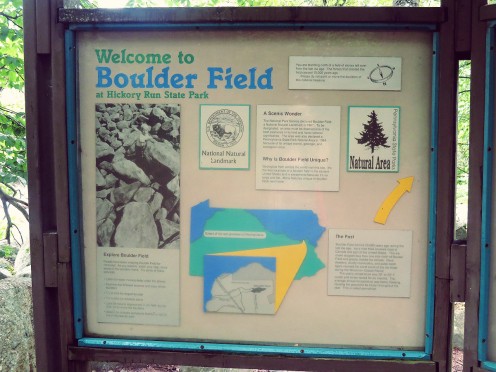Welcome to the next installation of my summertime Pocono Mountains series! Today I’ll be exploring Boulder Field, a well-known local spot that’s both unique and rather iconic!
Boulder Field is located in Hickory Run State Park off route 534, which can be accessed from I-80 or the nearby turnpike (I-476) if you’re coming from out of town, or from local back roads around Jim Thorpe and the Split Rock/Big Boulder area. If you explore around this area in general, you’ll find many smaller boulder fields (which I’ve traversed previously), but the main one is of course the most well known. What exactly is Boulder Field, you ask? Well, it’s a giant field. Of boulders. No kidding!
Finding rocks out in nature is no big deal, but a large field of boulders like this is highly unusual. Boulder Field was made roughly 20,000 years ago during the last glacial period in North America. The simplest way perhaps of explaining the formation of the field (as best as scientists can determine – much of their information is still theory) is that, during the last ice age, the glacier never actually covered Boulder Field, but made it cold enough to freeze the ground, expose bedrock (the Pocono rock), and create permafrost. With fluctuating temperatures between the day and night though, freeze-thaw and frost-heave created cracks in the bedrock. Because Boulder Field actually lies on a slope, gravity naturally played into the formation of the boulders once the bedrock cracked. The rocks moved due to a process called gelifluction, or the downward movement of sand, water, rock, and ice particularly in geographical areas like the Poconos. Similar to the process of how potholes are created in wintertime, the bedrock of Boulder Field cracked and eventually broke into the large boulders as it sloped downward and was “moved” by the flow of water, ice, mud, and sand. Today, water still runs beneath Boulder Field. Geography is awesome!!
The boulders are naturally rounded rather than jagged because of having collided and “rubbed” against one another for so long. Large boulders lie on the top of the field because they have greater surface area and allowed smaller boulders to “fall” below. The indentations in the field that are seen today are evidence of this process and movement. In some places, these large indentations have generated stories about their origins, often weaving into the history of the surrounding area. A hike in Central PA a couple years ago led me to a place called “Indian Wells,” an area similar to boulder field but on the top of a ridge, where large indentations in the rocks were present (the story goes that Indians created these impressions to collect water, hence “Indian Wells”).
The road to Boulder Field is usually closed in the winter due to snow and ice, but those willing to hike the three miles in can still access it. In summer, many snakes make their home in Boulder Field, so it is crucially important to take caution when walking across the boulders. Some of the rocks are loose, so taking your time is a smart idea. Spiders are also abundant, but they normally just scurry away into the depths of the rocks when you approach.
Unfortunately, Boulder Field has seen lots of vandalism in recent years, including the spray painting and defacing of the actual boulders. To maintain Boulder Field as it exists today, natural occurrences aside, it is important not to move the boulders or remove them. Like anything in nature, leave nothing but footprints and take nothing but memories!
Boulder Field is great for a day adventure. You can even picnic out on the rocks while doing some exploring! Once you get the hang of walking across them, the boulders don’t pose too much of a challenge. I’ve seen really young children and even pets traverse them with no problem. It’s certainly an incredible sight to see and absolutely worth the visit!
For more information and posts about the Poconos, click the image below!




